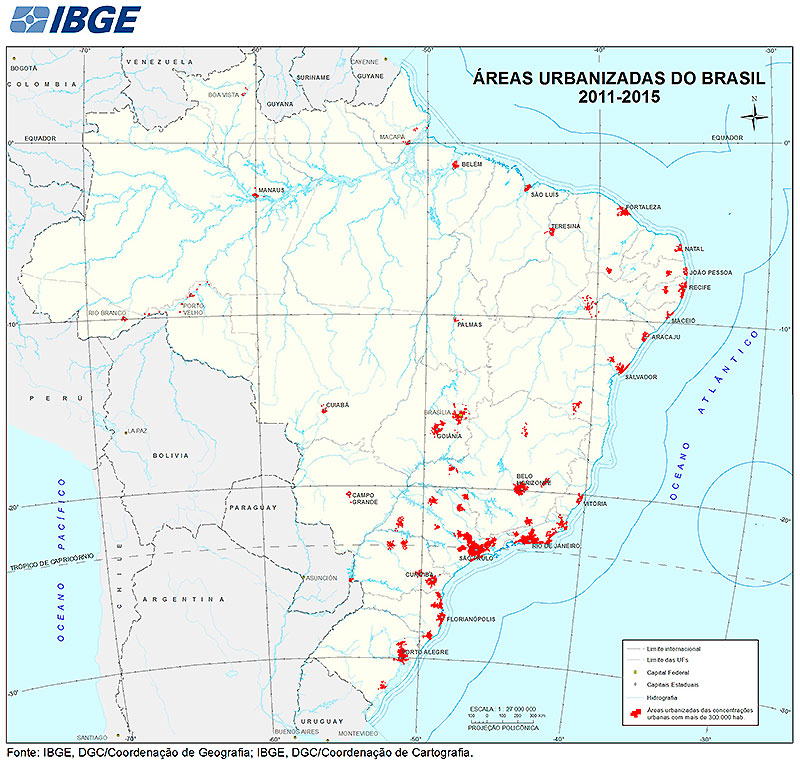New study shows current state of Brazilian urbanization
July 27, 2017 10h00 AM | Last Updated: September 04, 2017 09h32 AM
The IBGE releases today the Urbanized Areas of Brazil 2015 publication (link) Now in its second edition, this project returns more modern and aligned with the needs of the Sustainable Development Goals - SDGs of the United Nations. The study aims at providing an overview of the urbanized areas in Brazil on top of a consolidated basis. It expects to help the surveys that approach the urban form and its regional differences, the influence of geographic aspects in the conformation of urbanized areas and the identification of trends and potential vectors to expand the cities, as well as to help the formulation of public policies and investments.

The publication includes a methodological report with the objectives and operational procedures adopted, both in the identification of the urbanized areas in Brazil and in their classification and calculation. It also presents the first results, related to the urbanized areas of the Urban Concentrations in Brazil above 300 thousand inhabitants, as well as to the municipalities of Palmas (TO) and Boa Vista (RR). Such mapping will eventually include the urbanized spots of urban concentrations with a smaller demographic size.
Of the 15,167.4 km² of the area mapped by the survey, 13% are located in the Urban Concentration of São Paulo, followed by Rio de Janeiro (10%) and Belo Horizonte (5%). Of the 15 largest Urban Concentrations according to their urbanized areas, only two are not state capitals: Campinas (SP), the eighth largest urbanized area, and São José dos Campos (SP), ranked in the 12th position. It should be highlighted that the municipalities of Palmas (TO) and Boa Vista (RR) were included as they are headquarters of Federation Units, though with a population out of this ranking. The 15 largest Urban Concentrations are:
| Urban concentrations with population above 300.000 inhab e municipalities of Boa Vista (RR) and Palmas(TO) | Area | ||||
|---|---|---|---|---|---|
| km² | Percentage (%) | ||||
| Total | Dense | Less dense | Dense | Less dense | |
| Total | 15167.40 | 13927.22 | 1240.18 | 91.82 | 8.18 |
| São Paulo/SP | 2016.20 | 1879.52 | 136.68 | 93.22 | 6.78 |
| Rio de Janeiro/RJ | 1505.55 | 1432.83 | 72.72 | 95.17 | 4.83 |
| Belo Horizonte/MG | 786.59 | 654.59 | 132.00 | 83.22 | 16.78 |
| Brasília/DF | 680.14 | 626.50 | 53.63 | 92.11 | 7.89 |
| Porto Alegre/RS | 675.93 | 626.22 | 49.71 | 92.65 | 7.35 |
| Curitiba/PR | 581.22 | 551.65 | 29.57 | 94.91 | 5.09 |
| Goiânia/GO | 538.09 | 479.05 | 59.04 | 89.03 | 10.97 |
| Campinas/SP | 474.38 | 439.23 | 35.15 | 92.59 | 7.41 |
| Fortaleza/CE | 397.05 | 366.69 | 30.36 | 92.35 | 7.65 |
| Recife/PE | 389.79 | 362.16 | 27.63 | 92.91 | 7.09 |
| Salvador/BA | 348.77 | 340.70 | 8.08 | 97.68 | 2.32 |
| São José dos Campos/SP | 290.82 | 257.66 | 33.16 | 88.60 | 11.40 |
| Vitória/ES | 245.60 | 229.19 | 16.41 | 93.32 | 6.68 |
| Manaus/AM | 241.26 | 231.48 | 9.79 | 95.94 | 4.06 |
| Belém/PA | 229.91 | 218.28 | 11.63 | 94.94 | 5.06 |
An up-to-date satellite, RapidEye, was used in this edition, producing more detailed images with its five-meter resolution. Another feature was the classification of the urbanized areas as "dense" – with a small spacing between the buildings and a continuous urban occupation – and "less dense" – with a more spaced occupation, characterized by allotments under construction and by a transition from a rural to an urban landscape.
Objectives of the Sustainable Development
The SDGs were adopted during the United Nations Summit on Sustainable Development in 2015. Of the 17 actions of this document, the Urbanized Areas of Brazil 2015 publication is inserted in SDG 11, related to sustainable cities and communities.
The products are available here. This study can also be accessed in the Interactive Geographic Platform, where users can view the urbanized areas together with other geographic units, allowing a number of analyses. The Platform is available on here.
Comunicação Social
27 de julho de 2017

